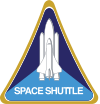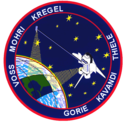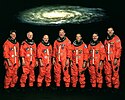STS-103
| Missionsemblem | |||||
|---|---|---|---|---|---|
 | |||||
| Missionsstatistik | |||||
| Missionsnavn: | STS-103 | ||||
| Rumagentur: | NASA | ||||
| Rumfærge: | Discovery (27) | ||||
| Antal besætningsmedlemmer: | 7 | ||||
| Affyringsrampe: | LC-39B (KSC) | ||||
| Opsendelse: | 19 december 1999 | ||||
| Landing: | 27 december 1999 | ||||
| Landet på: | Kennedy Space Center | ||||
| Varighed: | 7 dage, 23 timer | ||||
| Foto af besætningen | |||||
 | |||||
| Navigation | |||||
| |||||
STS-103 (Space Transportation System-103) var Discoverys 27. rumfærge-mission.
Opsendt 19. december 1999 og vendte tilbage den 27 december 1999.
Missionen var servicemission 3.A (den tredje) til Hubble-rumteleskopet i rumfærge-programmet.
Hubble var blevet opsendt med STS-31, men teleskopet havde en fejl der blev repareret på STS-61 servicemission 1; servicemission 2 blev udført af STS-82 missionen.
Efterfølgende servicemissioner til Hubble: STS-109 servicemission 3.B (den fjerde) og den femte og sidste Hubble-mission med rumfærgerne er STS-125 servicemission 4 planlagt i sommeren 2008.
Hubble har seks gyroskoper og skulle dengang bruge mindst tre for at virke. Tre af dem svigtede og NASA besluttede at opdele den planlagte servicemission 3 med forventet opsendelse i juni 2000 i servicemission 3A og 3B. 3A skulle være en fremskyndet reparationsmission og 3B skulle som planlagt udskifte instrumenter. Den 13. november 1999 svigtede det fjerde gyroskop og Hubble blev sat i dvale med låget sat foran kikkertåbningen. NASA turde ikke risikere at Hubble ved et uheld pegede mod solen og brændte sine sensorer af. I december 1999 reparerede Discoverys astronauter Hubble men de måtte opgive at udføre alle opgaverne. På grund af Y2K-problemet skulle Discovery lande før nytåret 1999-2000.
Besætning

 Curtis Brown (kaptajn)
Curtis Brown (kaptajn)
 Scott Kelly (pilot)
Scott Kelly (pilot)
 Steven Smith (1. missionsspecialist)
Steven Smith (1. missionsspecialist) /
/
 Michael Foale (2. missionsspecialist)
Michael Foale (2. missionsspecialist)
 John Grunsfeld (3. missionsspecialist)
John Grunsfeld (3. missionsspecialist)
 Claude Nicollier (4. missionsspecialist) ESA
Claude Nicollier (4. missionsspecialist) ESA
 Jean-Francois Clervoy (5. missionsspecialist) ESA
Jean-Francois Clervoy (5. missionsspecialist) ESA
Arbejder på Hubble
- For at kunne dreje Hubble mod diverse objekter og for at kunne fastholde teleskopet mod disse har Hubble fire svinghjul. Til at kontrollere bevægelsen har Hubble seks gyroskoper der altid peger i samme retninger som reference. Tre gyroskoper bruges ad gangen og tre er i reserve. De roterer med 19.200 o/min og slides med tiden. Fire af de seks gyroskoper var i stykker men Hubble blev udstyret med seks friske gyroskoper. Hubble fik tidligere nye gyroskoper i 1993.
- For at Hubble kan pege mod et bestemt mål har den tre Fine Guidance Sensor (FGS) der indeholder spejle, prismer og linser. De er en slags søgekikkerter der angiver retningen med stor præcision. FGS1 blev udskiftet med den FGS der blev hentet ned på servicemission 2 og senere ombygget, således at jordstationen kan aflæse den. Den udskiftede FGS skal selv ombygges og geninstalleres på servicemission 4 i 2008.
- Hubbles DF-224 computer blev opgraderet til en strålingshærdet Intel 80486 processor med 2 MB RAM. Den er tyve gange hurtigere end den gamle og har seks gange så meget hukommelse.
- Til opbevaring af data fra instrumenterne indtil de kan transmitteres havde Hubble fra starten af tre Engineering Science Tape Recorders (ESTR) båndstationer, på hver 1,2 GB. Der er mange bevægelige dele i en båndstation og båndene slides efterhånden. Derfor blev den ene båndstation udskiftet med en Solid State Recorder (SSR) halvlederbaseret hukommelse på 12 gigabyte. Hubble fik udskiftet den første båndstation i 1997.
- Den defekte S-båndsradiosender S-Band Single Access Transmitter (SSAT) blev udskiftet. Hubble har to SSAT til at sende data til jordstationen via Tracking and Data Relay Satellite netværk.
- Hubble-teleskopet omkredser Jorden på 97 minutter og skifter fra at være i den brændende sol til den iskolde jordskygge. For at undgå at teleskopet slår sig ved bratte temperaturændringer er Hubble pakket ind i isolerende tæpper. Disse er med tiden mørnet af ultraviolet stråling og klodsede astronauter. NOBL (New Outer Blanket Layer) er specialsyede stykker der anbringes ovenpå de værst medtagne steder. Tre NOBL blev lagt på af Discoverys astronauter og fire skal lægges på på senere missioner.
- Hubble-teleskopet kredser rundt i termosfæren og nedbremses ganske langsomt af den ekstremt tynde luft. Discovery steg op til 570 km mens Hubble var koblet til rumfærgen. Da Hubble ikke har nogen raketmotor er denne procedure nødvendig.
- Rumvandring ved Hubble
Hovedartikler:
 | Wikimedia Commons har medier relateret til: |
Eksterne henvisninger
- STS-103 Arkiveret 16. februar 2016 hos Wayback Machine NASA (engelsk)
- Hubble missioner Arkiveret 6. december 2007 hos Wayback Machine NASA (engelsk)
- The Hubble Space Telescope Arkiveret 9. februar 2012 hos Wayback Machine NASA (engelsk)
- Servicing Mission 3A Arkiveret 21. september 2008 hos Wayback Machine (engelsk)
Medier brugt på denne side
STS099-(S)-001 (JUNE 1999) STS-99 INSIGNIA -- The crew members designed the flight insignia for the Shuttle Radar Topography Mission (SRTM), the most ambitious Earth mapping mission to date. Two radar antennas, one located in the Shuttle bay and the other located on the end of a 60-meter deployable mast, will be used during the mission to map Earth's features. The goal is to provide a 3-dimensional topographic map of the world's surface up to the Arctic and Antarctic Circles. The clear portion of Earth illustrates the radar beams penetrating its cloudy atmosphere and the unique understanding of the home planet that is provided by space travel. The grid on Earth reflects the mapping character of the SRTM mission. The patch depicts the Space Shuttle Endeavour orbiting Earth in a star spangled universe. The rainbow along Earth's horizon resembles an orbital sunrise. The crew deems the bright colors of the rainbow as symbolic of the bright future ahead because of human beings' venturing into space.
SVG version of PNG Space Shuttle Logo/Patch.
Forfatter/Opretter: Askeuhd, Licens: CC BY-SA 4.0
Astronauts Steven L. Smith, and John M. Grunsfeld, appear as small figures in this wide scene photographed during extravehicular activity (EVA). On this space walk they are replacing gyroscopes, contained in rate sensor units (RSU), inside the Hubble Space Telescope. A wide expanse of waters, partially covered by clouds, provides the backdrop for the photograph. Based on raw scan and retouched using Negative Lab Pro.
Forfatter/Opretter: Kwamikagami, Licens: CC BY-SA 4.0
symbol of Mars. 16 × 16 pixel nominal dimensions, lines 2 pixel thick, square caps. Colour 75% blue: red=0 green=0 blue=191 (#0000BF).
STS093 (S)-001 (Sept. 1998) --- The STS-93 mission patch, as designed by the five crew members. The STS-93 mission will carry the Advanced X-ray Astrophysics Facility (AXAF) into low Earth orbit initiating its planned five-year astronomy mission. AXAF is the third of NASA's great observatories, following the Hubble Space Telescope and the Compton Gamma Ray Observatory. AXAF will provide scientists an order-of-magnitude improvement over current capabilities at X-ray wavelengths. Observations of X-ray emissions from energetic galaxies and clusters, as well as black holes, promise to greatly expand current understanding of the origin and evolution of our universe. The STS-93 patch depicts AXAF separating from the Space Shuttle Columbia after a successful deployment. A spiral galaxy is shown in the background as a possible target for AXAF observations. The two flags represent the international crew, consisting of astronauts from both the United States and France. The NASA insignia design for Shuttle flights is reserved for use by the astronauts and for other official use as the NASA Administrator may authorize. Public availability has been approved only in the form of illustrations by the various news media. When and if there is any change in this policy, which we do not anticipate, it will be publicly announced.
Rotated and color enhanced version of original (ISS013-E-48788 (6 July 2006) --- The Space Shuttle Discovery approaches the International Space Station for docking but before the link-up occurred, the orbiter "posed" for a thorough series of inspection photos. Leonardo Multipurpose Logistics Module can be seen in the shuttle's cargo bay. Discovery docked at the station's Pressurized Mating Adapter 2 at 9:52 a.m. CDT, July 6, 2006.)
Designed by the crewmembers, the STS-103 emblem depicts the Space Shuttle Discovery approaching the Hubble Space Telescope (HST) prior to its capture and berthing. The purpose of the mission is to remove and replace some of the Telescope's older and out-of-date systems with newer, more reliable and more capable ones, and to make repairs to HST's exterior thermal insulation that has been damaged by more than nine years of exposure to the space environment. The horizontal and vertical lines centered on the Telescope symbolize the ability to reach and maintain a desired attitude in space, essential to the instrument's scientific operation. The preservation of this ability is one of the primary objectives of the mission. After the flight, the Telescope will resume its successful exploration of deep space and will continue to be used to study solar system objects, stars in the making, late phases of stellar evolution, galaxies and the early history of the universe. HST, as represented on this emblem was inspired by views from previous servicing missions, with its solar arrays illuminated by the Sun, providing a striking contrast with the blackness of space and the night side of Earth.
- The NASA insignia design for Shuttle flights is reserved for use by the astronauts and for other official use as the NASA Administrator may authorize. Public availability has been approved only in the form of illustrations by the various news media. When and if there is any change in this policy, which is not anticipated, it will be publicly announced.
These seven astronauts have been assigned as crew members for NASA's third servicing mission to the Hubble Space Telescope (HST). They are, from the left, astronauts C. Michael Foale, Claude Nicollier, Scott J. Kelly, Curtis L. Brown, Jr., Jean-Francois Clervoy, John M. Grunsfeld and Steven L. Smith. Brown and Kelly are commander and pilot, respectively. All the others are mission specialists (MS), with international MS Nicollier and Clervoy representing the European Space Agency (ESA).














